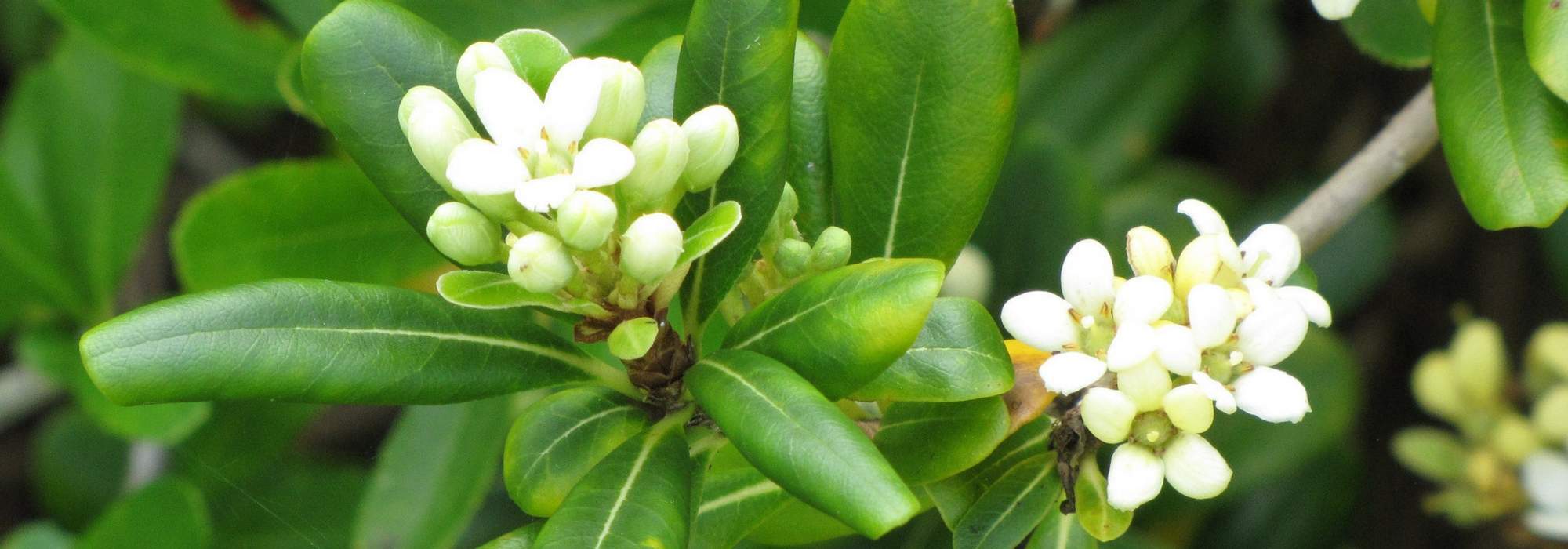
Pittosporum: planting, growing and pruning
Contents
Pittosporum in a nutshell
- Pittosporum is an evergreen bush offering a wide diversity of foliage, plain or variegated.
- Flowering of bell-shaped blooms occurs in spring.
- Its naturally compact, rounded habit allows it to be trained as topiary.
- Ideal for coastal locations or a Mediterranean-style dry garden.
- Pittosporum can be planted as a hedge or in beds and borders. It can also be grown in a pot.
A word from our expert
Pittosporum or Pittospore is an elegant bush, somewhat frost‑tender, much valued for its evergreen foliage that makes it decorative all year round. From the glossy green of a Pittosporum tobira, to the purple of a Pittosporum tenuifolium ‘Tom Thumb’, through variegated, speckled or golden varieties… Impossible not to fall under its charm!
Beyond the diversity of foliage, Pittosporums produce a flowering composed of charming bell‑shaped flowers in white, yellow, red or purple, depending on variety. Their appearance in spring, generally in May, is accompanied by a powerful orange blossom fragrance, especially noticeable on warm nights.
All Pittosporum species and varieties offer a harmonious, naturally rounded habit. They tolerate pruning very well and can easily be trained as topiary, to the point of outshining traditional box balls of box.

The variegated foliage of Pittosporum tenuifolium ‘Elisabeth’ is very decorative.
In the garden, Pittosporum readily finds a place in regions with mild climates, notably coastal areas whose sea spray it tolerates. It is often planted as a hedge, alone or with other Mediterranean bushes, such as oleander. It also structures borders and rockeries beautifully.
Its average hardiness is not an obstacle to cultivation in colder regions. Simply plant it in a pot, a culture it tolerates very well, so it can be overwintered easily. It nicely adorns a terrace or balcony from spring to autumn.
Easy to care for, Pittosporum is undemanding about soil type, although it prefers fairly fertile, and above all well‑drained, soil. It thrives in sunny situations sheltered from dry or cold winds. Once established, Pittosporum requires little maintenance, apart from a dressing of compost in early spring. It tolerates pruning well, even if pruning is unnecessary. It naturally retains a harmonious habit, further proof that it really is king of hedges in mild climates!
Description and botany
Botanical data
- Latin name Pittosporum
- Family Pittosporaceae
- Common name Pittosporum, Pittospore
- Flowering spring
- Height 0.80 to 10 m
- Exposure sun, partial shade
- Soil type well-drained
- Hardiness -4 to -10°C
Genus Pittosporum, in family Pittosporaceae, comprises around 200 species mainly native to New Zealand, Australia and New Caledonia, such as Pittosporum tenuifolium. Pittosporum tobira is native to Japan and China.
Pittosporums can reach up to 20 m or more in their native regions. In our latitudes, cultivated varieties rarely exceed 3 to 4 m. There are also dwarf varieties with a compact habit, such as Pittosporum tobira ‘Nanum’, ideal for low hedges. Pittosporum’s naturally compact, rounded habit also makes it easy to train as topiary, a fine alternative to box.
Size and appearance of foliage vary greatly between species and varieties. Some, like Pittosporum tenuifolium, have small, round, leathery leaves no more than 3 to 4 cm long, while others such as Pittosporum heterophyllum bear more elongated leaves that can reach 8 cm in length.

Pittosporum tobira – botanical illustration
Foliage diversity does not stop there: many colour variations exist. Varieties with glossy green foliage sit alongside gold, purple and variegated forms. Pittosporum tenuifolium ‘Elisabeth’ is one of the most striking, with white-edged leaves that turn red as seasons progress.
All Pittosporum species and varieties flower in spring, between May and June. Flowers may be white, yellow or even purple, and the diversity of their flowering matches that of their foliage. Even the most inconspicuous flowers emit a strong fragrance reminiscent of orange blossom. Flowering is followed by capsule-shaped fruits that burst at ripeness, revealing red, waxy seeds. These seeds can be easily harvested for sowing under a cold frame.
Not very hardy, Pittosporum tolerates pruning very well and resists sea spray, making it an ideal bush by the coast or in a dry, Mediterranean-style garden. In regions with harsh winters, particularly those subject to a montane climate, favour Pittosporum heterophyllum, one of the hardiest, or opt for planting in a pot.
Pittosporums grown in pots can therefore be overwintered easily in a bright, minimally heated room such as a conservatory.

Pittosporum tobira : foliage, flower buds, flower and fruits.
Species and varieties
Genus Pittosporum includes many species and varieties cultivated with different sizes, flowering times and foliage.
Most common species are Pittosporum tenuifolium, with small round leathery leaves, and Pittosporum tobira with more elongated leaves. Some varieties display foliage variegated with white or cream, and also more unusual colours such as purple.
Flowering, more or less discreet depending on variety, occurs in spring and brings a delightful scent reminiscent of orange blossom. Here too diversity of colours is great and the contrast with foliage is most elegant.
Note on hardiness: only to about -7°C. Most species and varieties need protection from frost, or should be grown in pots in climates subject to severe frosts.
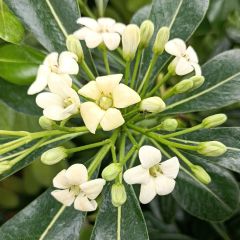
Pittosporum tobira
- Flowering time June
- Height at maturity 5 m
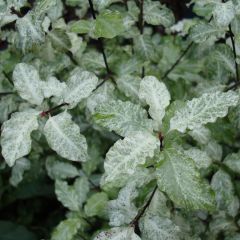
Pittosporum tenuifolium Irene Patterson - Kohuhu
- Flowering time June, July
- Height at maturity 1,50 m
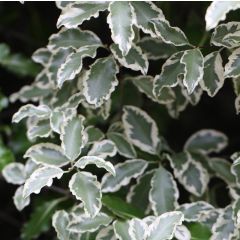
Pittosporum tenuifolium Elisabeth - Kohuhu
- Flowering time June, July
- Height at maturity 2 m
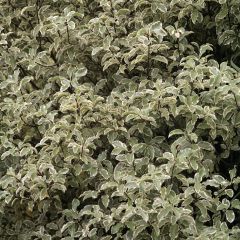
Pittosporum tenuifolium Variegatum - Kohuhu
- Flowering time June
- Height at maturity 2,50 m
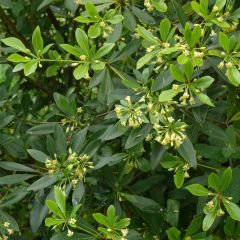
Pittosporum heterophyllum
- Flowering time June, July
- Height at maturity 2,50 m
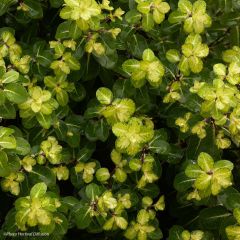
Pittosporum tenuifolium Abbotsbury Gold - Kohuhu
- Flowering time June, July
- Height at maturity 2,50 m
Discover other Pittosporum
View all →Available in 0 sizes
Available in 1 sizes
Available in 1 sizes
Available in 2 sizes
Available in 2 sizes
Available in 1 sizes
Available in 3 sizes
Available in 2 sizes
Available in 1 sizes
Available in 2 sizes
Planting Pittosporum
Where to plant it?
Moderately hardy, Pittosporum generally does not tolerate frosts below 7°C. Planting in open ground should therefore be reserved for regions with mild winters such as Mediterranean or Atlantic coast. Preferably provide a warm, full-sun exposure. A semi-shaded position is possible for some varieties, such as Pittosporum tenuifolium ‘Variegatum’, but bush will grow less and be less compact.
In regions with montane climate (Pyrenees, Alps, Massif Central, Jura…), favour a species offering good hardiness, such as Pittosporum heterophyllum, and site it sheltered from wind, for example against a south-facing wall. You can also opt for container planting and bring indoors for winter.
While Pittosporum is not very demanding regarding soil type, avoid overly calcareous soils and heavy soils that retain moisture. This bush does need good soil drainage to develop. It prefers drier rather than wetter soil, and soil fairly rich in organic matter.
Compact varieties, notably Pittosporum tobira ‘Nanum’, can be grown in a pot. They can thus be brought indoors during winter in climates that experience severe frosts.
When to plant Pittosporum?
Prefer planting in spring, between March and April, or alternatively in autumn, between September and October.
How to plant it?
Once location chosen:
- Dig a hole 2 to 3 times the volume of the rootball.
- Mix garden soil with leaf mould and coarse sand in equal proportion (50%).
- Place Pittosporum in position, leaving collar (junction between roots and soil) level with soil.
- Backfill with the mixture and firm down.
- Water immediately and generously.
- Mulch around base to help keep soil cool and moist.
- Water regularly afterwards to encourage establishment, once or twice a week.
For a hedge, space each Pittosporum about 1 m apart.
For container planting, provide a substrate made of garden soil, coarse sand and compost or potting compost in equal parts. Improve drainage by placing a layer of gravel or clay pebbles at the bottom of the pot.
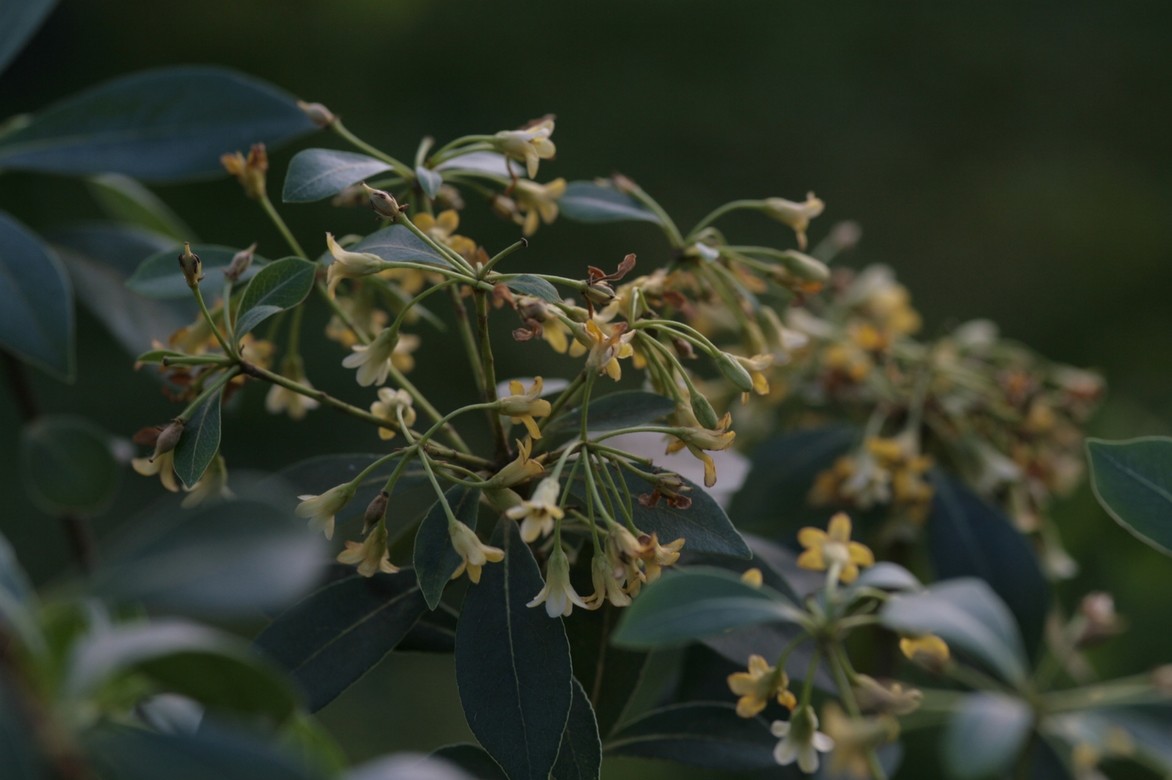
Delicate inflorescences of Pittosporum heterophyllum, with scent reminiscent of orange blossom.
Read also
How to choose your Pittosporum ?Care
Pittosporum can tolerate dry soil. However, to ensure optimal growth, water it once a week in summer.
This precaution is particularly necessary for plants grown in pots, as this cultivation method promotes evaporation of moisture from the substrate. Also give them a liquid feed once a month during growth (March to September).
In autumn, mulch around the base to protect the roots of your Pittosporums from frost. If exposed to cold winds, protect its foliage with a frost fleece.
Potted plants can be moved into a bright, frost-free space such as an unheated veranda. Reduce waterings, water once a month to prevent the substrate from drying out completely.
Apply compost in autumn or winter to encourage a lovely spring flowering.
Pruning Pittosporum
Pruning Pittosporum is not essential but helps maintain an airy, harmonious habit. It is carried out in mid-summer (late July), after flowering. Pruning in early spring is possible but removes flowering, so we do not recommend it if you want to enjoy its sweet fragrance.
Trim back tips of shoots to even them up. Remove branches growing inward and dead shoots. It is also possible to prune it as topiary.
In a pot, growth is slower, so stick to light pruning to rebalance habit of your Pittosporum if needed.
Virginie T. tells you more in the tutorial How to prune Pittosporum?
Diseases and parasitic organisms
Pittosporum has good resistance to disease. However, it can suffer mealybug infestations, particularly in late spring or early autumn when air is warm and humid.
These sap-sucking insects feed on plant sap, damaging its development. Their presence can lead to sooty mould forming on leaves. This black deposit prevents photosynthesis, which also harms Pittosporum growth. Moreover, it is simply disastrous aesthetically.
For prevention as well as treatment, we advise avoiding use of pesticidal products in favour of a natural method. For example, spray a mixture made from liquid black soap, methylated spirits and vegetable oil. Repeat every 8 days.
Note that no miracle cure guarantees eradication of mealybugs. Constant vigilance is your best ally, together with good growing conditions.
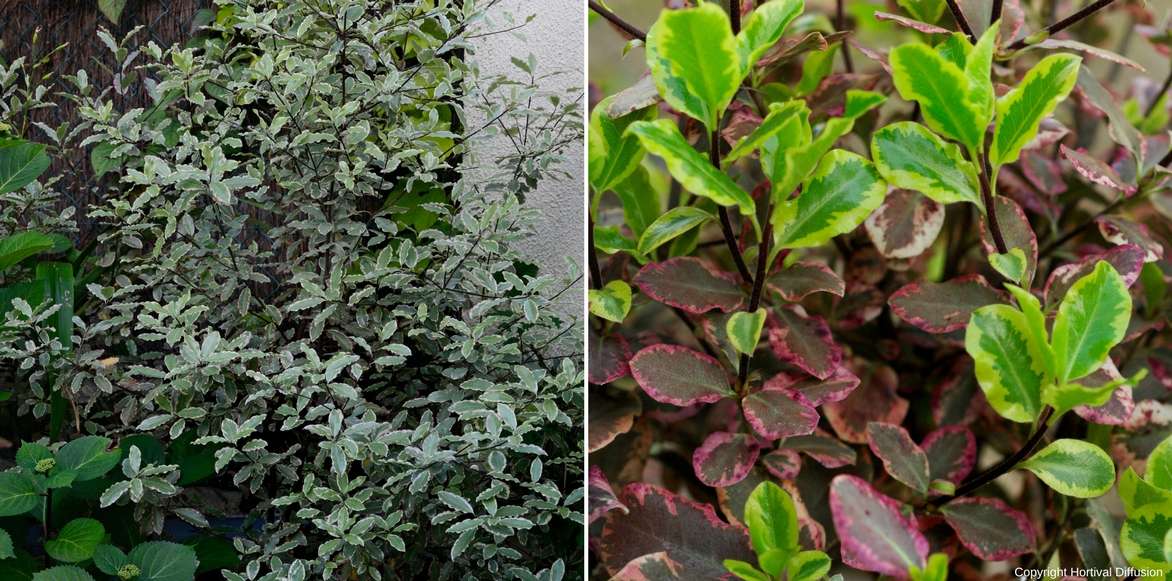
Variegated foliage of Pittosporum tenuifolium ‘Elisabeth’ changes colour with seasons.
Propagation
Pittosporum is easily propagated by propagation by cuttings or by sowing. However, favour propagation by cuttings, which is quicker and easier to carry out and will reproduce your favourite variety identically.
Sowing
Sowing Pittosporum seeds gives good results. However, patience is required: growth of these bushes is fairly slow.
- Harvest seeds at ripeness, when the red capsules split open in late autumn.
- Sow directly in a cold frame.
- Choose a bright position out of direct sunlight.
- Keep soil slightly moist.
First seedlings should appear within 30 to 60 days.
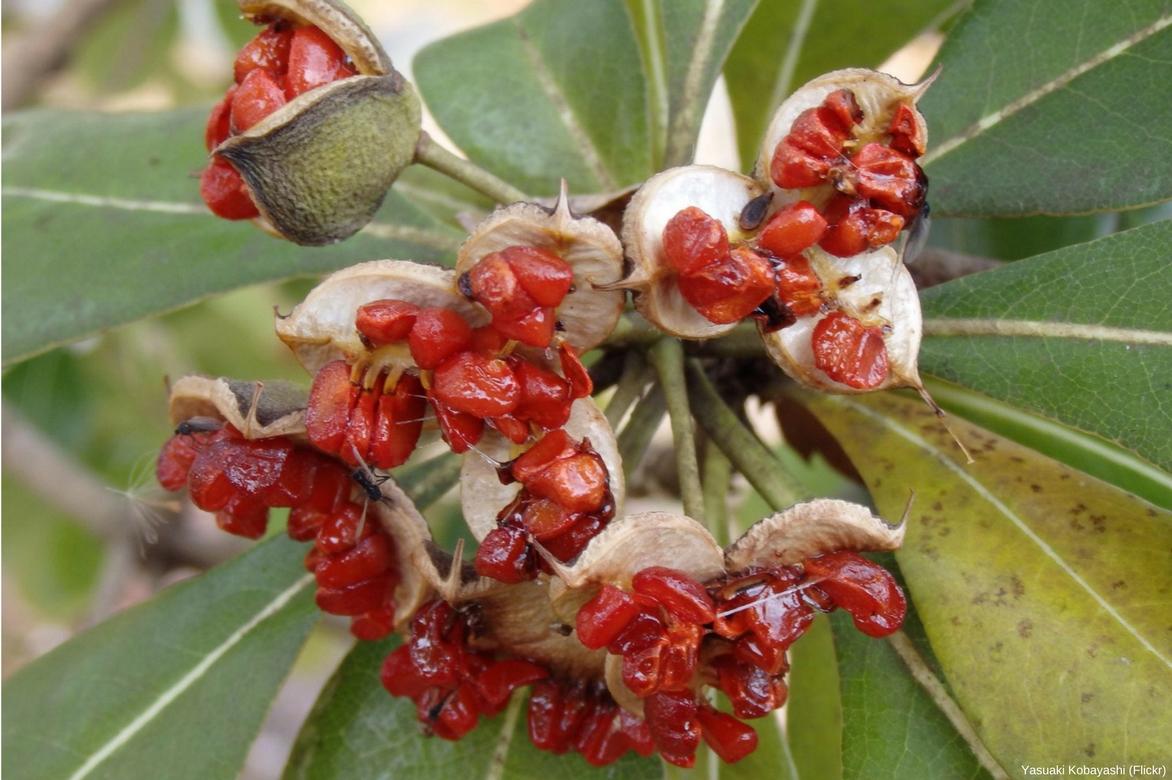
Seeds of Pittosporum tobira.
Propagation by cuttings
Propagation by cuttings of Pittosporums is carried out in summer, in July–August. The cutting is taken from a semi-lignified shoot, that is to say one that is beginning to take on the consistency of wood but remains flexible.
- Cut stems of about 15 cm from the tips of semi-lignified shoots.
- Plant them in pots in a light substrate such as compost for sowing. Keep moist.
- Keep covered, by placing half bottles or clear plastic bags over the pots.
- Pot on into a new pot when new leaves appear (may take several weeks).
- Keep cuttings between 5°C and 10°C during winter.
- Plant out in autumn.
Associations
In mild climate, Pittosporum is well suited to creating informal hedges. Don’t hesitate to vary the colours by combining the bright green of Chinese Pittosporums (Pittosporum heterophyllum) with the golden foliage of Pittosporum tenuifolium ‘Abbotsbury Gold’. Pittosporum can also be mixed with other Mediterranean bushes such as oleanders or eleagnus. Leave one metre between each young plant to allow them to develop.

An idea for combining plants in an informal hedge for mild climate: Nerium oleander / Pittosporum heterophyllum / Eleagnus ebbingei / Pittosporum tenuifolium ‘Abbostbury Gold’.
Use smaller varieties, such as Pittosporum tobira ‘Nanum’, to perfume your paths with their delicate scent. Pair them with other aromatic plants (lavender, rosemary…) to multiply olfactory pleasures, or with other bushes for low hedges such as abelias. They also add relief to a rockery or can be grown in pots to dress a terrace or balcony. Their compact habit makes them easy to train as topiary. Pittosporum also makes an excellent substitute for boxwood.
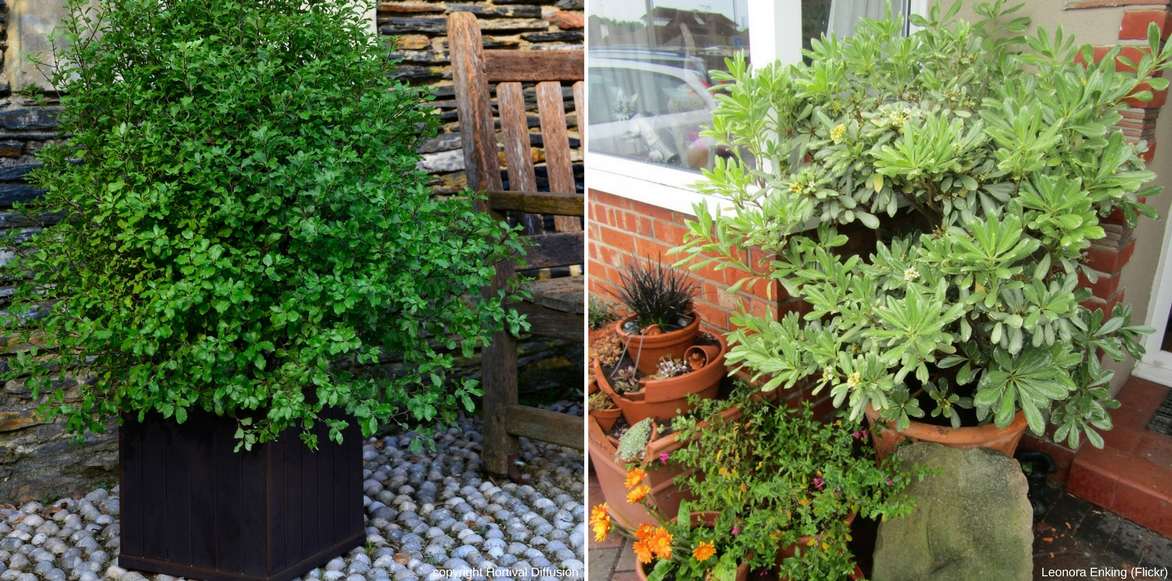
Pittosporum is well suited to container culture: Pittosporum tenuifolium ‘Emerald Gold’ / Pittosporum tobira ‘Variegata’.
If you are looking for a specimen capable of becoming a real focal point in your Mediterranean garden, fall for Pittosporum tenuifolium ‘Irene Patterson’ without hesitation. Its silver-speckled foliage offers a continual display, especially striking in spring when purplish-violet flowers appear, and equally delightful in winter when its leaves take on a delicate pink tinge.
Finally, Pittosporum is an ideal bush for structuring a bed or providing a dense, elegant backdrop. For a successful effect, vary shapes, habits and heights, and avoid planting in a straight line — use a staggered layout for a more natural result.
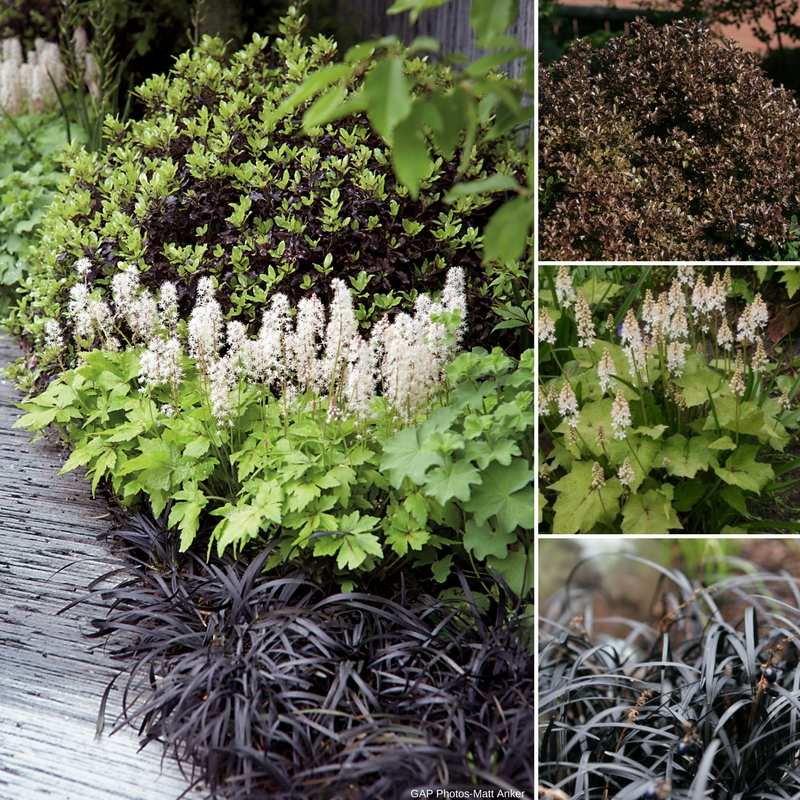
An example of a contrasting planting in a mixed border: Pittosporum tenuifolium ‘Tom Thumb’ / Tiarella cordifolia / Ophiopogon planiscarpus ‘Nigrescens’.
→ also read: Pittosporum: 5 ideas for successful plant combinations
Useful resources
Discover our wide range of Pittosporum ! Learn how to control mealybugs effectively. All Pascal’s advice for a beautiful flowering hedge: which bushes to plant, when and how? Advice sheet : How to choose your Pittosporum Tutorial : How to propagate Pittosporum?Frequently asked questions
-
Leaves of my potted Pittosporum are yellowing — what should I do?
Excess water can be the cause; space out watering and check substrate drainage. An application of organic fertiliser is also recommended in spring. Bushes grown in pots are no more demanding than those grown in the ground.
-
Leaves of my Pittosporum seem covered in resin — why?
This is probably honeydew secreted by scale insects. To try to eradicate them, spray a natural compound made from liquid black soap, methylated spirits and vegetable oil. Repeat spraying every 8 days until scale insects have disappeared.
- Subscribe!
- Contents































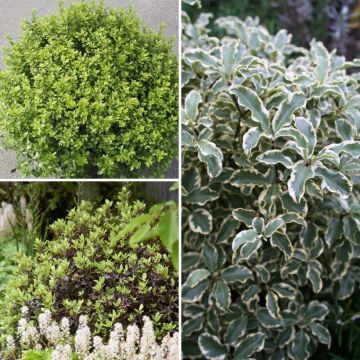
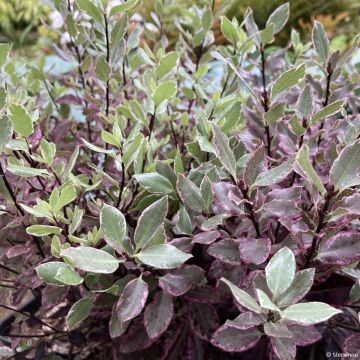


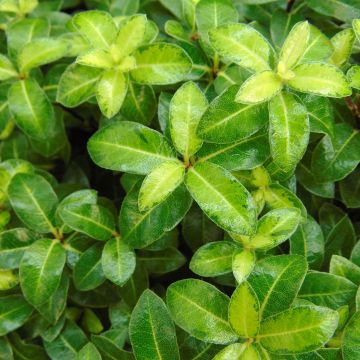



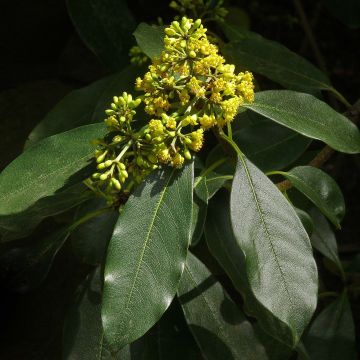
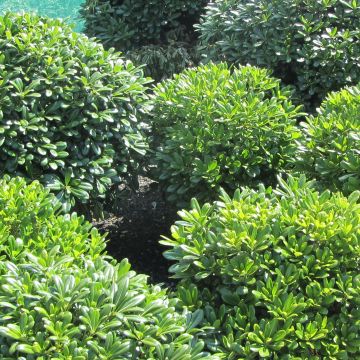
Comments